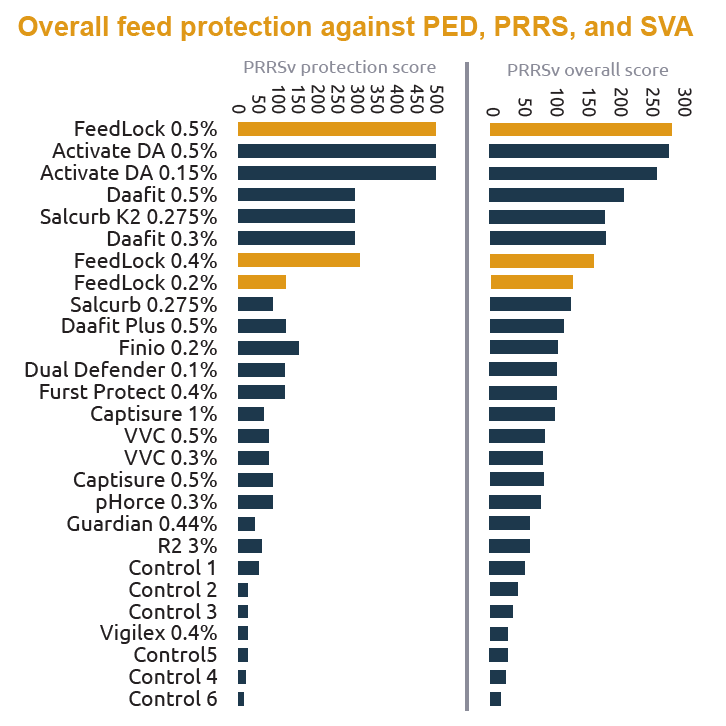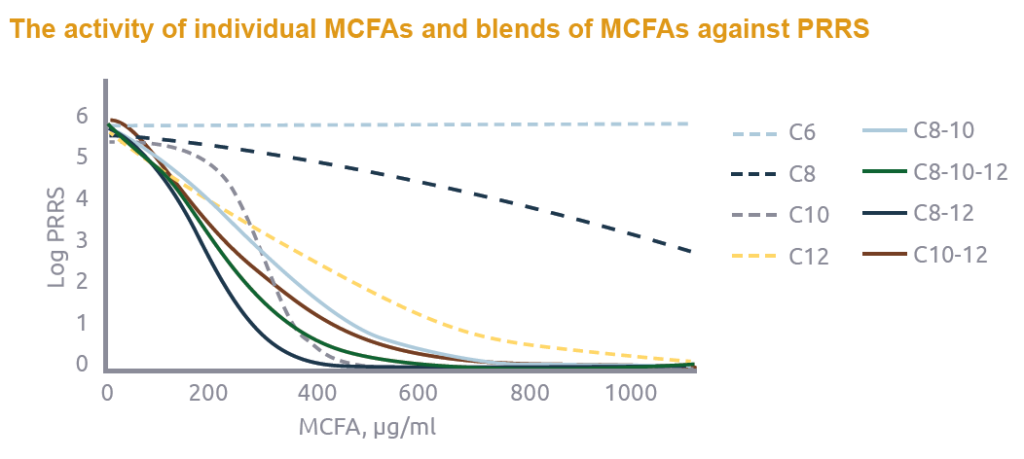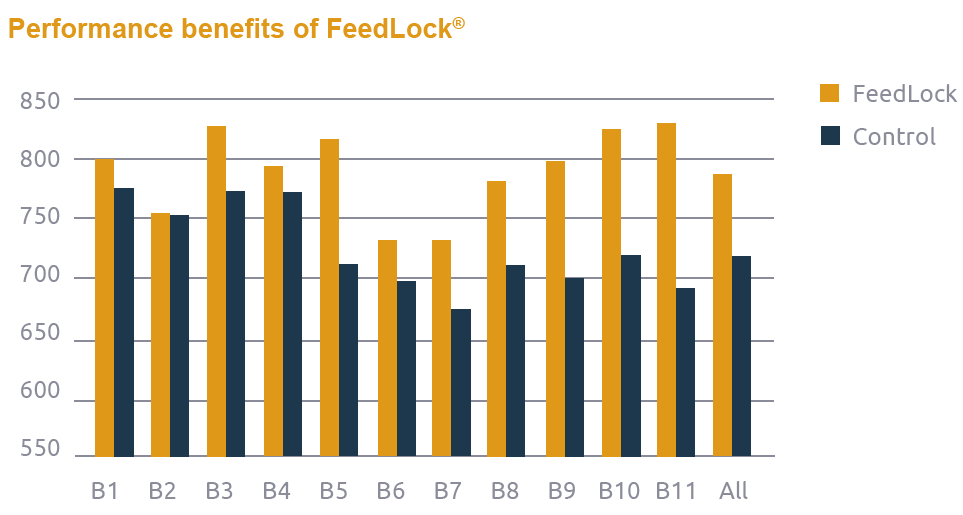A viral infection has the potential to decimate a farm’s animal population. For affected farmers, a viral infection is both financially and emotionally an enormous challenge. Besides vaccination, biosecurity has become the magical word for viral prevention, but in practice, it is hard to decide what control measures are a worthy investment. Therefore, combating viral infections is like playing a high-stakes card game. One route of infection, especially during a pandemic, is feed. Thankfully, incorporating control measures into the feed is arguably one of the easiest things to do, especially when such control measures have fringe benefits outside of preventing viral infections.
Feed is one of many vectors through which viruses can enter a farm. Feed can be contaminated by insects, rodent or bird droppings, or even contaminated feedstuff. Consequently, feed biosecurity should be considered as part of the farm’s biosecurity protocol. Although pelleting can kill viruses, it is not 100% effective and (re-)contamination can occur after the pelleting process. This is why, specific feed ingredients are a relatively new but effective tool helping producers with feed biosecurity.
Viruses as stealth weapons
For all practical purposes, viruses are stealth weapons. They have no metabolic activity and consequently can remain infectious in rather extreme conditions for extended periods of time. For example, hypoxia or dehydration does not faze them, and some can tolerate extremely low or high temperatures. Consequently, viruses can remain hidden in just about anything that enters a farm, including birds, rodents, insects, dust particles, and feed.
Once they enter the animal, viruses are anything but stealthy. They begin to rapidly replicate, and upon replication, they can damage host cells to the point the cells die through necrosis. Normally, cells die via apoptosis; this means the cells are neatly taken apart without causing any damage to surrounding cells. Necrosis, however, leads to the uncontrolled By Theo van Kempen (Global Swine Technical Lead) spilling of cellular components into the surrounding environment. This spillage can cause an overreaction of the immune system, which results in collateral damage, a so-called cytokine storm. A nice analogy of necrosis is destroying a house in a busy residential area with an explosive charge. Although effective at destroying the house, the explosion will cause wreckage to fly around and damage buildings around the house. A much neater way would be to simply dismantle the house piece by piece and possibly even use some of this material to build a new house. Viruses, unfortunately, use the explosive method.
Biosecurity
The two key tools for managing viral disease are vaccination and biosecurity. Vaccinations—although costly and labor intensive—work great for specific viruses that evolve slowly, while biosecurity is technically a great tool for controlling a whole range of pathogens. There are many handbooks written on how to set up and optimize farm biosecurity. The trick to biosecurity is the execution of all those rules, especially on larger farms where staff changes frequently and the owner struggles to keep an eye on things.
Feed as a vector for viral infections has received renewed attention after the devastating 2018 African Swine Fever (ASF) outbreak in China. Consequently, specific feed ingredients have been developed to provide a ‘permanent’ protection against viruses.
MCFAs as a disinfectant and immune stimulant
Medium-chain fatty acids (MCFAs) are the building block of soap, the same soap surgeons use to disinfect their hands prior to entering a surgery room. This soap effect demonstrates how MCFAs can kill microbes, including viruses. Consequently, MCFAs can harm all forms of life if the route of exposure and dose is sufficiently high. What makes MCFAs unique is that animals have the ability to quickly metabolize MCFAs as an effective energy source. Practically, this means MCFAs can be lethal to a virus or a bacterium without harming the host itself. In fact, the host benefits from the energy contained in the MCFAs, and consequently MCFAs are a zero residue functional feed ingredient.
A more recent finding is that MCFAs can also have direct immune-boosting properties. They can trigger receptors within the immune system that subsequently boost phagocytosis (the uptake of pathogens by immune cells, which results in their destruction) and can stimulate the production of immunoglobulins.
Independent proof of the efficacy of MCFAs for preventing viral spread
Pipestone research
Driven by concerns over ASF and porcine reproductive and respiratory syndrome (PRRS), an academic project was carried out to test 15 commercial products (several of them tested at multiple inclusion levels) marketed for their ability to reduce viral spread through feed. For this experiment, pigs were managed in line with commercial practices, except that each room was isolated from other rooms to prevent the spread of infection between rooms. Feeds were prepared with the various test products per their respective label instructions. On days 0 and 6 of the experiment, a block of ice containing large doses of PRRS, porcine epidemic diarrhea virus (PED), and Senecavirus (SVA)—sufficient to render the animals sick—was dropped into the feed bin with the aim to expose the animals to infectious doses for each of the three viruses.
The health of the animals was subsequently monitored over a period of 15 days:
- Animals were scored for visible signs of the diseases
- Saliva and feed samples were collected on days 6 and 15, which were analyzed by PCR for the presence of
- Thirty out of the 96 pigs (focusing on animals with disease symptoms) were necropsied and analyzed for viral presence and signs of disease
- For each virus, a protection score was calculated and an overall protection score was determined
FeedLock® provides maximum protection
Of all tested products, FeedLock® (at 0.5% of the complete feed) provided the best protection against PPRS (Figure 1a), with no signs of disease noted at all the doses tested. PED turned out to be harder to control: across all treatments, nearly 1 in 3 pens had signs of diarrhea. Though it did not prevent signs of disease in all pens, FeedLock® again scored well relative to competitors for PED. Finally, for SVA, FeedLock® was again able to prevent pigs from getting sick at all the doses tested.
Combining the scores against the three viruses into an overall protection score yielded the results shown in Figure 1b.

Purdue University
A series of experiments were performed at Purdue University to evaluate the impact of MCFAs on PRRS. Two strains of PRRS were used: a North American variant and a European variant. For this experiment, PRRS-infected mammalian cells were used, which is a common model for PRRS infections. These infected cells were exposed to individual MCFAs or to blends of MCFAs. After exposure, the viral presence was determined.
For the individual MCFA, C10 was especially effective at reducing the PRRS titer; a dose of 300 ppm resulted in a 1000-fold reduction (Figure 3). However, the blends of fatty acids were even more effective with a blend of C8 & C12 reducing the viral titer by a 1000-fold at 200 ppm (Figure 2).

MCFAs and performance
Medium-chain fatty acids have been in use as natural alternatives to antimicrobials. The above trials outline the benefits of MCFAs for feed hygiene and immune stimulation. Combined, the incorporation of MCFAs into feed for preventing viral contamination will not only improve the biosecurity at a farm, but will also directly improve intestinal health inside the animal and, through that, animal performance. Indeed, performance trials with FeedLock® have shown performance benefits that easily offset the cost of the product (Figure 3).

Viral infections can devastate farms, which is why biosecurity is high on the agenda for farmers. A cost-effective tool to help prevent the introduction of viruses onto the farm through feed is FeedLock®. Independent efficacy trials confirm FeedLock®. as the lead feed biosecurity functional feed ingredient available today. As it is based on the already proven antimicrobial platform technology, MCFAs, it can also boost animal health even when there is no viral threat. This makes FeedLock® a win-win; peace of mind without a cost penalty.
References are available upon request.
